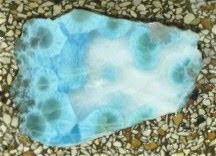Piece of Dominican Blue Amber as seen in the rough
Amber is supposed to be amber color, right? Not exactly. There is the original colors of Amber, yellow, orange, honey, cognac or similar. A new delight among jewelry designers is Butterscotch Amber, found in the Baltic as well as the Middle East. But there also is cream, cherry, red, green and even blue, which is by far the rarest of all the Ambers. Up to this day many people do not believe in the existence of "BLUE" amber. Must be something in the air or in the ground, since two of the more highly prised gemstones that come from the Dominican Republic are both "BLUE" - Blue Amber and Larimar.
Chunk of Dominican Amber with Reds-Cognac-Yellow coloring.
Is Blue Amber Truly Blue? No. It is not. And yet, it is. Confused? Blue Amber is a result of fluorescence and no solid color exists. Ultra-violet or violet light is re-emitted as blue or green light, attributed to the presence of poly-nuclear aromatic molecules. Therefore, Blue amber is blue, but not the way you might think.
When sunlight strikes the Blue Amber on a white surface the light particles pass right through and are refracted by the white surface. Result: the Blue amber looks almost like any other Amber, only with a light blue hue. But when the light particles can't pass through and refract back, the hydrocarbons in the Blue Amber turn the sun's ultraviolet light into blue light particles. The result: the famous blue glow of Blue Amber. This effect is only possible with Dominican Blue Amber pieces graded within the Blue Amber category. Any other Amber (like Baltic and others) will not display this blue phenomenon at all. And, on top of that other Dominican Amber will show this blue efraction only in concentrated UV light, and not in natural light. Light passed through the Blue Amber from a flashlight, will also result in the normal looking cognac amber color.
Example of same piece of Blue Amber with front lighting, then looking as same piece lighted from the reverse
Thanks to The Amber Ranch for the pieces of and the info on Dominican Blue Amber










